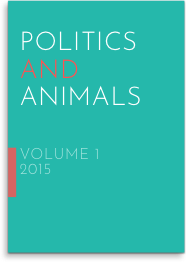References
- Aaltola, E. (2015). Politico-moral apathy and omnivore’s akrasia: Views from the rationalist tradition. Politics and Animals, 1(1), 35-49.
- Adams, C. J. (1990). The sexual politics of meat: A feminist-vegetarian critical theory. Cambridge, MA: Polity Press.
- Adams, C. J., & Donovan, J. (Eds.). (1995). Animals and women: Feminist theoretical explorations. Durham, NC: Duke University Press.
- Adams, C. J., & Donovan, J. (Eds.). (2007). The feminist care tradition in animal ethics: A reader. New York, NY: Columbia University Press.
- Birke, L. (1994). Feminism, animals, and science: The naming of the shrew. Buckingham, England: Open University Press.
- Cavalieri, P. (2015). The meaning of the Great Ape Project. Politics and Animals, 1(1), 16-34.
- Cavalieri, P., & Singer, P. (Eds.). (1993). The great ape project: Equality beyond humanity. London, England: Fourth Estate.
- Cochrane, A. (2010). An introduction to animals and political theory. New York, NY: Palgrave Macmillan.
- Cochrane, A. (2012). Animal rights without liberation: Applied ethics and human obligations. New York, NY: Columbia University Press.
- Dolgert, S. (2015). Animal republics: Plato, representation, and the politics of nature. Politics and Animals, 1(1), 75-88.
- Donaldson, S., & Kymlicka, W. (2011). Zoopolis: A political theory of animal rights. Oxford: Oxford University Press.
- Donaldson, S., & Kymlicka, W. (2015). Farmed animal sanctuaries: The heart of the movement? Politics and Animals, 1(1), 50-74.
- Flynn, C. P. (Ed.). (2008). Social creatures: A human and animal studies reader. New York, NY: Lantern Books.
- Franklin, A. (1999). Animals and modern cultures: A sociology of human-animal relations in modernity. London, England: Sage.
- Gålmark, L. (2005). Skönheter och odjur: En feministisk kritik av djur-människa-relationen. Göteborg, Sweden: Makadam.
- Garner, R. (1996). Animal rights: The changing debate. New York, NY: New York University Press.
- Garner, R. (1998). Political animals: Animal protection politics in Britain and the United States. New York, NY: St. Martin’s Press.
- Garner, R. (2005.) The political theory of animal rights. Manchester, England: Manchester University Press.
- Garner, R. (2013). A theory of justice for animals: Animal rights in a nonideal world. Oxford, England: Oxford University Press.
- Kean, H. (1998). Animal rights: Political and social change in Britain since 1800. London, England: Reaktion Books.
- Kete, K. (2002). Animals and ideology: The politics of animal protection in Europe. In N. Rothfels (Ed.), Representing animals (pp. 19-34). Bloomington, IL: University of Illinois Press.
- Kete, K. (2007). Introduction: Animals and human empire. In A cultural history of animals in the age of empire (pp. 1-24). Oxford, England: New York, NY: Berg.
- Luke, B. (2007). Brutal: Manhood and the exploitation of animals. Urbana, IL: University of Illinois Press.
- Milligan, T. (2015). The political turn in animal rights. Politics and Animals, 1(1), 6-15.
- Nibert, D. A. (2002). Animal rights/human rights: Entanglements of oppression and liberation. Lanham, MD: Rowman & Littlefield.
- Nibert, D. A. (2013). Animal oppression and human violence: Domesecration, capitalism, and global conflict. New York, NY: Columbia University Press.
- Noske, B. (1997). Beyond boundaries: Humans and other animals. Buffalo, NY: Black Rose Books.
- O’Sullivan, S. (2011). Animals, equality and democracy. Basingstoke, England: Palgrave Macmillan.
- Pachirat, T. (2011). Every twelve seconds: Industrialized slaughter and the politics of sight. New Haven, CT: Yale University Press.
- Patterson, C. (2002). Eternal Treblinka: Our treatment of animals and the Holocaust. New York, NY: Lantern Books.
- Ritvo, H. (1987). The animal estate: The English and other creatures in the Victorian Age. Cambridge, MA: Harvard University Press.
- Ritvo, H. (1997). The platypus and the mermaid, and other figments of the classifying imagination. Cambridge, MA: Harvard University Press.
- Ryder, R. D. (2000). Animal revolution: Changing attitudes toward speciesism (2nd ed.). Oxford, England: Berg.
- Sanbonmatsu, J. (Ed.). (2011). Critical theory and animal liberation. Lanham, MD: Rowman & Littlefield.
- Schlosberg, D. & Wissenburg, M. L. J. (Eds.). (2014). Animal politics and political animals. Basingstoke, England: Palgrave Macmillan.
- Smith, K. K. (2012). Governing animals: Animal welfare and the liberal state. New York, NY: Oxford University Press.
- Spiegel, M. (1989). The dreaded comparison: Human and animal slavery. New York, NY: Mirror Books.
- Taylor, N., & Twine, R. (Eds.). (2014). The rise of critical animal studies: From the margins to the centre. London, England: Routledge.
- Tester, K. (1991). Animals and society: The humanity of animal rights. London, England: Routledge.
- Thomas, K. (1984). Man and the natural world: Changing attitudes in England 1500-1800. Harmondsworth, England: Penguin.
- Torres, B. (2007). Making a killing: The political economy of animal rights. Oakland, CA: AK Press.
- Wadiwel, D. J. (2015). The war against animals. Boston, MA: Brill.
- Weil, K. (2010). A Report on the Animal Turn. Differences, 21(2), 1-23. http://doi.org/10.1215/10407391-2010-001
- Wyckoff, J. (2014a). Linking sexism and speciesism. Hypatia, 29(2), 721-737.
- Wyckoff, J. (2014b). Toward justice for animals. Journal of Social Philosophy, 45(4), 539-553.

